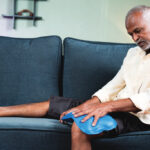Dr. Spiera explained that some other studies of IL-6 inhibitors in PMR have used protocols with more rapid glucocorticoid tapers in both arms, whereas they compared sarilumab with a very rapid glucocorticoid taper vs. more traditional glucocorticoid doses in the comparator arm. “I think what we were replicating in the comparator arm was that in the real world, we try to take people off steroids,” he said. “Moreover, I think that is where the unmet need is—these patients who you could leave on steroids for a longer period.”
The study met its primary end point: Of the patients in the sarilumab arm, 28% achieved remission compared to only 10% in the comparator arm (P=0.02); when normalization of CRP was dropped from the definition of sustained remission, 32% of patients on sarilumab achieved it compared to 14% of patients on placebo (P=0.03). This trend continued in analysis of individual components defining remission, including the percentage of patients achieving remission by week 12, when the treatment group was on 2 mg of prednisone vs. approximately 8 mg in the placebo group.
“[The study protocol] had a very high bar for defining remission,” Dr. Spiera said.
These stringent criteria may have played a role in decreasing these remission rates compared to some other existing trials of IL-6 inhibitors in PMR that used more relaxed measures of remission. The rapid glucocorticoid taper may also have decreased remission rates in the treatment group compared with studies that allowed additional glucocorticoids at higher and/or longer doses.
The proportion of patients without any PMR signs and symptoms was also higher in the sarilumab arm compared with placebo, increasing as soon as week 2 and continuing to increase until week 52, with a similar trend observed when excluding patients who required glucocorticoid treatment as rescue therapy. Patients in the sarilumab arm were also less likely to flare after achieving clinical remission (17% vs. 29%; hazard ratio 0.56; P=0.02).
The cumulative corticosteroid dose was also higher in patients in the placebo group. Dr. Spiera pointed out that some of that was due to 52-week taper in this group, but the difference between the anticipated steroid use and actual steroid use, the difference in rescue steroids, was statistically significantly lower in the sarilumab group (P=0.02) A higher proportion of patients in the comparator arm also required additional glucocorticoids as rescue therapy compared to the sarilumab arm (59% vs. 32%; P=0.0053).


